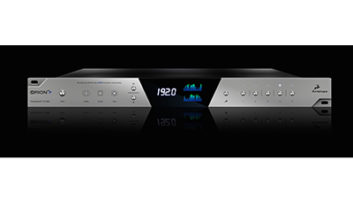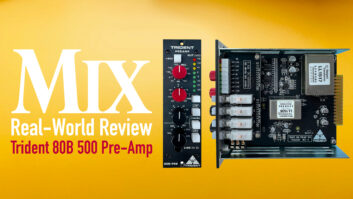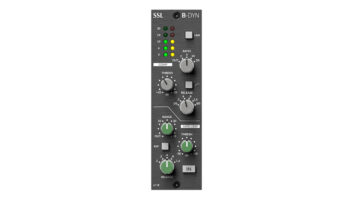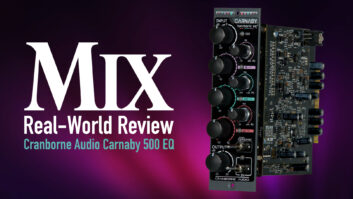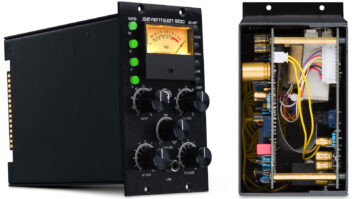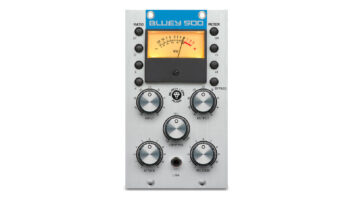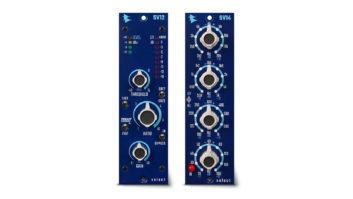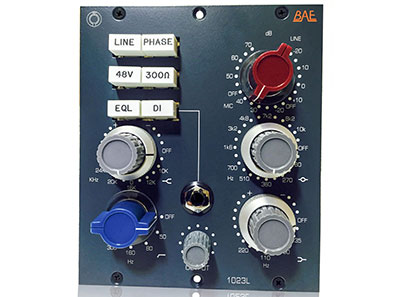
The 1023L is BAE’s single-rackspace 1023 mic pre/EQ module repackaged into a three-slot 500 Series module. Like the 1023, the 1023L has an all Class-A circuit design comprising a mic preamp with up to 80 dB of gain followed by a 3-band equalizer section and 18dB/octave highpass filter. Like the original Neve 1073 module, it offers a choice between 300- and 1,200-ohm microphone input impedances, and there is a 20-position rotary switch for changing gain in 5dB steps, from -20dB line level up to +70dB microphone level.
There are front panel switches for Line/Mic, Phase (polarity flip), 48-volt phantom power on/off, EQ in/out, 1,200/ 300-ohm mic input impedance, and a DI switch for activating the (150k-ohm) ¼-inch front panel direct input jack. Being a 500 Series module, the same rear panel edge connector input connection is shared for both microphone and line-level inputs. Along with the vast amount of gain available for either mic or line-level sources, this opens up interesting overdrive possibilities.
Compared to the original Neve 1073, the 1023L’s expanded range of EQ frequency choices is significant and noteworthy. Unlike the 1073’s high-frequency shelving EQ fixed at 12 kHz, the 1023L’s high-frequency section is similar to the Neve 1084 module with its selectable 10, 12, and 16 kHz frequencies and adds 20 and 24 kHz for a total of five frequencies.
On the Inside
A close look inside the 1023L reveals solid-looking hand wiring for all the rotary controls and switches. There are five printed circuit boards that plug into a hand-soldered motherboard—exactly the same as the inside of the rackmount version. Swiss-made Elma rotary switches are used throughout, and Carnhill VTB9045 and VTB9046 transformers are used for the microphone and line-level input paths, respectively.
A large Carnhill VTB1148 output transformer drives loads down to 65 ohms and Carnhill St. Ives inductors are used on both the low and midrange EQ boards. A Traco Power DC-to-DC module is used to convert the 500 rack’s ±16-volt supply voltages into a single +24-volt rail. Because the 1023L occupies three slots, there is more than enough current available for the DC-to-DC conversion. In my testing, I had no headroom issues driving my Pro Tools 192 I/Os calibrated for +4 dBu operating level—it worked identically as an original Neve 1073 module.
In the Studio
The 1023L fit perfectly and took up half of my six-slot API 600B Lunchbox. Operationally, I found it better to locate the module (and API rack) higher up in my outboard rack directly in front of me. After a few sessions, I could find “frequencies of interest” on the three EQ sections more by “feel” or by ear and without actually reading them on the densely packed front panel. I liked this, and also the centrally located output level control; it’s easy to find in a hurry and set recording levels precisely “on the fly.”
Inserted into my Pro Tools mixes, I found that the 1023L worked fabulously and I reserved it for top-level mix elements—“high-line” lead vocals and solos, whenever I wanted that classic, warm and fat Neve tone. Pushing more level into the module using the Mic/Line Gain control is a time-tested, smooth tone enhancer for cleanly recorded tracks.
My first recording was an ordinary-sounding Ibanez Model AEF18LE acoustic guitar. I used an Audio-Technica AT4081 active ribbon microphone placed at the 12th fret, the 300-ohm impedance position, and 60dB gain position. I went straight to the analog input of my HD192—no special A/D or I/O box. I used the 50Hz highpass position and +2dB @ 10kHz shelving. This mic requires phantom power so I muted the output, before turning it on/off and before switching input impedance to avoid a loud “pop.” I thought this mic and the 1023L produced a servable acoustic guitar feel with a thick sound good for chunking rhythms. To be honest, it sounded better than it did out in the room!
The 1023L shines as the ultimate electric guitar tone-sculpting tool with loads of tonality choices built on settings of the Mic/Line Gain, Output control, and equalizer. Pushing low frequencies tends to break up the sound sooner in a very pleasing way and the midrange equalizer frequency choices (including the new ones) hit all the best spots when recording guitars. I liked this expanded EQ over the 1073’s to carve individual guitar tracks to mesh together as required—there is nothing like this sound.
I started with a Shure KSM8 Dualdyne dynamic microphone placed off-center of the 12-inch speaker’s dust cover. The amp sound heard out in the studio was set clean for my Fender Strat. I used 50 dB of gain and the Output knob straight up at 12 noon and no EQ. So much gain produced a grungy sound back in the control room and I found by setting the highpass filter at 160 Hz and then boosting at 110 Hz (shelving) I could dial in just the right amount of low-frequency “size” to fit in with the “wire choir” guitar production.
A big surprise was boosting up to +18dB the high-frequency EQ set to 20 or 24 kHz; this added a shimmer and airiness akin to standing in front of the amp out in the studio. Backing the 1023L’s gain down in the 25 or 30dB area and running the output control full up cleans up the preamp’s sound, and I was able to hear the sonic details of the amp, the guitar and the studio’s room.
My guitar player used a Suhr custom electric guitar with both humbuckers and single-coil pickups. This time I used a RØDE NTR active ribbon mic (figure-8 pattern) close in and aimed directly at the center of the speaker’s dust cover. The 1023L was at minimum gain (20dB position) and I used the EQ’s 510Hz, 700Hz and 1.6kHz positions for either boosting or for scooping out. I used the highpass filter set to 50 Hz or 80 Hz and I liked to also boost 80 Hz using the shelving low-frequency section at the same time. You can do the something similar with a Pultec EQ, but I like this better. I then had the option of switching in the high-frequency shelving section at 10kHz to dial-in the overall brightness.
The 1023L’s handy DI input worked well for a Yamaha RBX 170 four-string electric bass guitar. Again the EQ section offered plenty of ways to dial in a sound but using a little too much gain to slightly overdrive the Retro Doublewide compressor next door (slot) in the rack worked together as an awesome team.
Fitting the original circuit, three transformers and the rest of the quality components into a three-slot 500 Series module is no easy trick. To have it operate well, include additional features, expand the EQ frequency choices and also sound great is an amazing feat. The 1023L is a worthwhile investment for any studio. I’ll take two, please!
Barry Rudolph is an L.A.-based engineer/educator. Visit him at www.barryrudolph.com.
TRY THIS
For vocals, I used my transformer mic splitter box to connect the same condenser microphone to both the BAE 1023L and one of the channels in my (transformerless) Millennia Media HV-37 preamp. I purposely used more gain than necessary and cranked the Output knob down halfway on the BAE, but kept the HV-37 totally clean. I recorded to two separate tracks, and during the mix I had the luxury of comparing and mixing together these two vastly different-sounding recordings.
Product Summary
COMPANY: BAE Audio
PRODUCT: 1023L 500 Series Module
WEBSITE:www.baeaudio.com/products/1023l
PRICE: $2,400 MAP
PROS: Many tonal choices, great classic sound.
CONS: None found.
